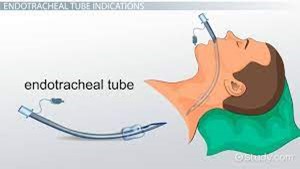When assessing the hemodynamic information for a newly admitted patient in shock of unknown etiology, the emergency department nurse will anticipate the administration of large volumes of Lactated Ringers (LR) when which one of the following occurs?
The mean arterial pressure (MAP) is 50 mm Hg.
Cardiac Out (CO) is 4 L/min
Stroke volume 70 ml/beat
The heart rate is 80 bpm.
The Correct Answer is A
Mean arterial pressure (MAP) is a measure of the average pressure within the arteries during one cardiac cycle. It represents the perfusion pressure that drives blood flow to organs and tissues. In the context of shock, a MAP of 50 mm Hg is considered low and indicates inadequate tissue perfusion.
To improve tissue perfusion and restore blood pressure, the nurse would anticipate administering large volumes of intravenous fluids, such as Lactated Ringers (LR). Fluid resuscitation aims to increase intravascular volume and improve cardiac output, ultimately leading to improved tissue perfusion.
B. Cardiac Output (CO) is 4 L/min in (option A) is incorrect because Cardiac output represents the volume of blood pumped by the heart per minute. While a low cardiac output may require intervention, it does not specifically indicate the need for large volumes of fluid administration.
C. Stroke volume is 70 ml/beat in (option C) is incorrect because Stroke volume refers to the volume of blood ejected by the heart with each contraction. While stroke volume can be an important determinant of cardiac output, it alone does not indicate the need for large fluid volumes.
D. The heart rate is 80 bpm in (option D) is incorrect because: Heart rate is the number of heartbeats per minute. While the heart rate can impact cardiac output, it does not provide direct information about fluid resuscitation needs.
Nursing Test Bank
Naxlex Comprehensive Predictor Exams
Related Questions
Correct Answer is C
Explanation
The nurse should listen over both lung fields to ensure that air entry is present bilaterally, indicating that the tube is correctly positioned in the trachea. This comes after observing chest movements.
B. Using an end-tidal CO2 monitor to check for placement in the trachea in (option B) is incorrect because End-tidal CO2 monitoring can provide confirmation of correct tube placement in the trachea by detecting exhaled CO2 levels. However, it requires additional equipment and setup, which may not be readily available at the bedside or immediately accessible.
C. Observing the chest for symmetrical movement with ventilation is the initial action after placing an endotracheal tube.
D. Obtaining a portable chest radiograph to check tube placement (option D) is incorrect because Chest radiographs are commonly used to confirm endotracheal tube placement, especially for long-term confirmation or if there are concerns about placement. However, obtaining a portable chest radiograph may involve delays and is not the initial action to be taken for immediate verification.
Therefore, the best initial action by the nurse to verify the correct placement of an endotracheal tube (ET) after insertion is to auscultate for the presence of bilateral breath sounds.

Correct Answer is A,B,D,C
Explanation
A. Decreased blood volume: Burn injuries can lead to fluid loss, primarily through damaged skin. This fluid loss causes a decrease in blood volume, leading to hypovolemia. Hypovolemia contributes to decreased cardiac output and tissue perfusion.
B. Increased vascular permeability: Burn injuries cause an inflammatory response, leading to increased vascular permeability. This increased permeability allows fluid, electrolytes, and proteins to leak from the intravascular space into the interstitial space.
C. Development of edema: The increased vascular permeability and fluid leakage lead to the development of edema. Edema occurs as fluid accumulates in the interstitial spaces, further contributing to tissue swelling and compromised perfusion.
D. Increased peripheral resistance: In response to decreased blood volume and tissue hypoperfusion, the body activates compensatory mechanisms to maintain blood pressure and tissue perfusion. One of these mechanisms is increased peripheral resistance, which occurs as blood vessels constrict to maintain blood pressure. Increased peripheral resistance helps redirect blood flow to vital organs but also contributes to increased workload on the heart.
Therefore, the correct sequential order of events involved in burn shock following a patient's exposure to burns is:
A. Decreased blood volume B. Increased vascular permeability D. Development of edema C. Increased peripheral resistance
Whether you are a student looking to ace your exams or a practicing nurse seeking to enhance your expertise , our nursing education contents will empower you with the confidence and competence to make a difference in the lives of patients and become a respected leader in the healthcare field.
Visit Naxlex, invest in your future and unlock endless possibilities with our unparalleled nursing education contents today
Report Wrong Answer on the Current Question
Do you disagree with the answer? If yes, what is your expected answer? Explain.
Kindly be descriptive with the issue you are facing.
